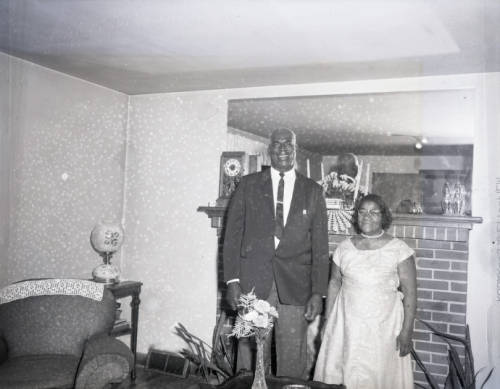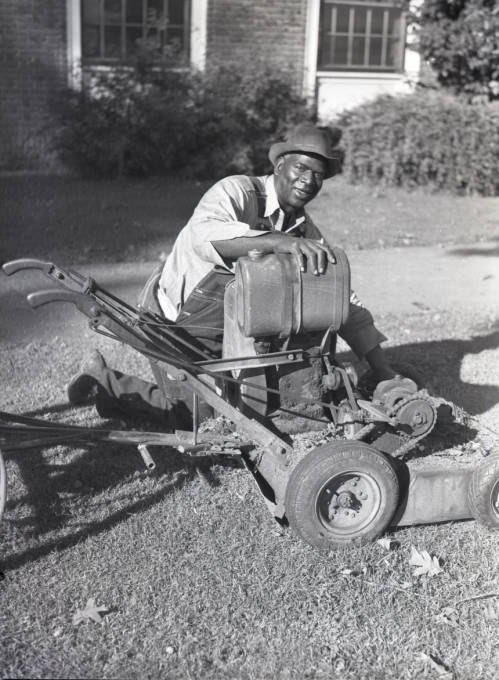- Home
- Teaching about Anti-Black Racism from Elon’s History
- Teachable Moments
- Andrew Morgan: Paternalism and Presence
Andrew Morgan: Paternalism and Presence
About Andrew Morgan
Andrew Morgan was among the earliest African Americans employed by Elon College. He began working at Elon in 1926 as the campus maintenance worker and worked continuously for the school until his death in 1964. An obituary in the Alumni News mourned the passing of “one of the oldest and best-loved employees of Elon College,” even though the school denied admission to black students until the last year of Morgan’s life. Snapshots from Morgan’s career thus present the opportunity to explore what it meant to be among Elon’s the “best-loved” staff members in the age of Jim Crow.
Photo Gallery
Timeline
- 1896Plessy v. FergusonSupreme Court case Plessy v. Ferguson rules racial segregation legal allowing the creation of "Jim Crow" laws. "Jim Crow" laws created "separate but equal" spaces for whites and blacks.
- 1900Andrew MorganAndrew Morgan is born on April 3, 1900 in Alamance County to Peter and Eliza Cooper Morgan.
- 1926Joining ElonAndrew Morgan begins working at Elon College as the campus maintenance worker after leaving his job as an assembly line worker at a local textile mill.
- 1942"In the Land of Cotton"The 1942 edition of PhiPsiCli featuring the theme, "In the Land of Cotton" was published. This edition of the Elon College yearbook featured heavily stereotyped images of Black Americans at work.
- 1954Brown v. Board of EducationSupreme Court case Brown v. Board of Education declares that segregation is unconstitutional.
- 1963Glenda Phillips HightowerIn the Fall of 1963 Glenda Phillips Hightower becomes the first full-time African American student admitted to Elon College.
- 1964Civil Rights Act & DeathIn July of 1964 the Civil Rights Act was signed, prohibiting discrimination of any kind. In August of 1964 Andrew Morgan dies while repairing a pipe under his house.
- 2012Memories of Andrew MorganFormer Elon President James Earl Danieley and Andrew Morgan's great niece, and one of Elon's first black staff members, Janice Ratliff are interviewed by a group of students about their memories of Andrew Morgan for a class project.
Sources
Primary Sources
Primary Sources are “traces of the past,” or firsthand accounts that people have left behind. Since they are firsthand accounts, they reflect the perspective of their author. They can be incomplete, hard to understand, and even distributing. For each of the sources below, consider who wrote the source, under what circumstances, and for what purposes.
- Excerpts from the Elon Yearbook (Phi Psi Cli) – Most Black staff did not appear in the yearbook, and Morgan was no exception. Student editors included photos of Morgan in a handful of years, however. Please see these pictures of Morgan (1936 and 1958), as well as the full yearbooks for those years (1936 and 1958) in order to provide context.including.
- “Introducing! Powerhouse Gang Andy, Arthur, and Buck,” Maroon and Gold (Oct. 5, 1940) – A white writer for the student newspaper revealed how he and his classmates thought about Andrew Morgan, his first cousin Arther Morgan, and Joseph Cousin—all Elon employees—in this remarkable article.
- United States Federal Census, Manuscript Returns, Households of Andrew Morgan and Leon Edgar Smith (1940) – The Federal Census contains a wealth of information about individuals. In 1940, for instance, the census taker recorded the names of every person living in a household, as well as the number of hours worked and the annual salary. Morgan’s household shows some of the nieces and nephews whom he and his wife, Hattie, adopted as their own. Then Elon President Leon Edgar Smith’s entry is a useful point of comparison.
- Earl Danieley, “Eulogy: Andrew Morgan Was a Big Man” (Aug. 30, 1964) – Then President Earl Danieley delivered the eulogy for Morgan at Morgan’s church, Archer’s Grove Christian Church and remembered Morgan as a “Big Man.”
- Luther Byrd, “Andy Morgan is Killed while Working on Plumbing,” Alumni News, 23, n. 1 (Sept. 1964) – Luther Byrd wrote the announcement of Morgan’s death in the Alumni News, in which he described the conditions of Morgan’s death, his role on campus, and his family.
- Earl Danieley, Interviews by Professor Prudence Layne and her college writing class, Spring 2012, transcript in Elon University Special Collections – Emeritus President Earl Danieley reflected on Morgan’s life. In addition to reading a transcript of his 1964 eulogy, he offered additional anecdotes and observations about the experiences of Black staff at Elon.
- Janice Ratliff, interview by Charles Irons, fall 2020, transcript in Elon University Special Collections. Ratliff, Morgan’s great-niece, offered her recollections of the Morgan household.
Secondary Sources
Secondary Sources are scholarly accounts, written at a remove from the action itself and with additional interpretation and analysis. While historians most frequently use the primary/secondary source distinction, scholars from many different disciplines have contributed important insights about the nature of systemic racism. Scholars for a long time ignored Black staff on college campuses completely, so most scholarly accounts explore the 1960s to the present.
- Peter Magdola and Liliana Deman, “Campus Custodians in the Corporate University: Castes, Crossing Borders, and Critical Consciousness,” Anthropology and Education Quarterly, 47, n. 3 (2016): 246-263. – Magdola and Deman examine how hard it is to cross borders between university subcultures and address why “the ever-present gap between campus castes (e.g., scholars vs. service workers) appear(s) to be growing wider.”
- Erik Ludwig, “Closing in on the ‘Plantation’: Coalition Building and the Role of Black Women’s Grievances in Duke University Labor Disputes, 1965-1968,” Feminist Studies, 25, n. 1 (Spring 1999): 79-94. – Morgan died in the beginning of a period of massive institutional change in which universities accepted Black students but only slowly altered policies for Black staff. The experience of Shirley Ramsey at nearby Duke University (Durham, NC) illustrate the kinds of struggles Black staff faced in the 1960s.
- Jennifer F. Hamer and Clarence Lang, “Race, Structural Violence, and the Neoliberal University: The Challenges of Inhabitation,” Critical Sociology, 41, n. 6 (2015): 897-912. – Hamer and Lang do not address historical inequalities but are rather probe the gap between the values that universities profess and the structural relationships of power they reproduce.
- Charles W. Eagles, “‘I Love Colored People, but in Their Place’: Segregation at Ole Miss,” in The Price of Defiance: James Meredith and the Integration of Ole Miss (Chapel Hill: University of North Carolina Press, 2009). – The politics of race and labor at Ole Miss and Elon in the age of segregation have a great deal in common.
- Ana S. Q. Liberato, Dana Fennell and William L. Jeffries IV, “I Still Remember America: Senior African Americans Talk About Segregation,” Journal of African American Studies, 12, n. 3 (Sept. 2008): 229-242. – The authors describe through an analysis of ten interviews how Black Americans coped with the traumas of segregation.
In-Class Work
Any of the primary sources individually merits a close reading. Taken together, they offer good possibilities for in-class work. Examples include:


